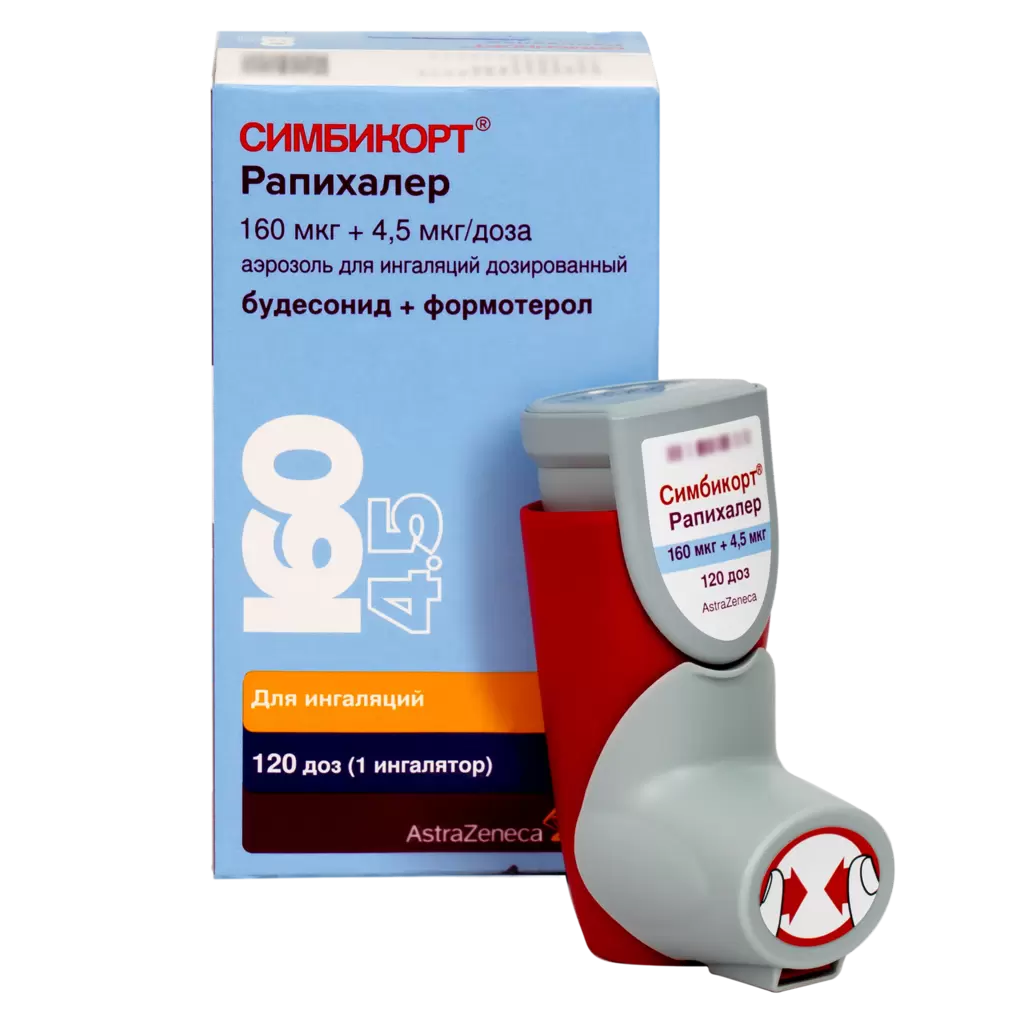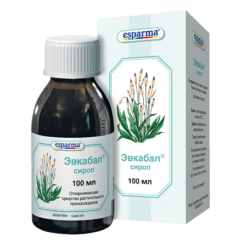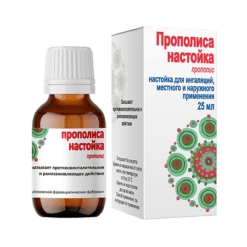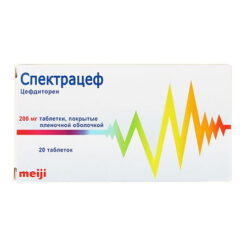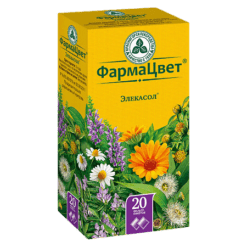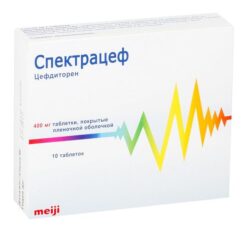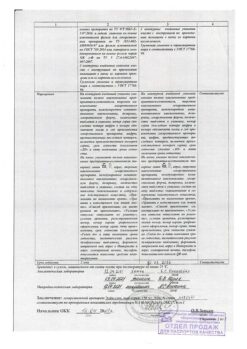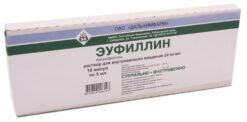No products in the cart.
Symbicort Rapihaler, 160 mcg+4, 5 mcg/dose aerosol 120 doses
€77.94 €64.95
Description
Pharmacotherapeutic group: bronchodilator combined (beta2-adrenomimetic selective + local glucocorticosteroid)
ATX code: R03AK07
Pharmacological properties
Pharmacodynamics
Simbicort® contains budesonide and formoterol, which have different mechanisms of action and have an additive effect in reducing the frequency of exacerbations of bronchial asthma. The special properties of budesonide and formoterol make it possible to use their combination to relieve attacks/symptoms with an anti-inflammatory effect, or as maintenance therapy for bronchial asthma.
Budesonide. Budesonide is a glucocorticosteroid that has a rapid (within hours) and dose-dependent anti-inflammatory effect on the airways after inhalation, reducing the severity of symptoms and the frequency of exacerbations of bronchial asthma. When prescribing inhaled budesonide, there is a lower incidence of serious adverse effects than when using systemic glucocorticosteroids. It reduces the severity of bronchial mucosal edema, mucus production, sputum formation and airway hyperresponsiveness. The exact mechanism of anti-inflammatory action of glucocorticosteroids is unknown.
Formoterol. Formoterol is a selective b2-adrenoreceptor agonist, after inhalation of which there is rapid and prolonged relaxation of bronchial smooth muscle in patients with reversible airway obstruction. The dose-dependent bronchodilator effect occurs within 1-3 minutes after inhalation and persists for at least 12 hours after a single dose.
Symbicort® Turbuhaler®: Budesonide + Formoterol Bronchial asthma
Clinical effectiveness of Symbicort® as an anti-inflammatory attack/symptom therapy: For anti-inflammatory seizure/symptom control (therapy A) and as maintenance therapy and for anti-inflammatory seizure/symptom control (therapy B)
. A total of 7 double-blind clinical trials enrolled 20140 patients with bronchial asthma, 7831 of whom were randomized to therapy with Symbicort® for attack/symptom control with anti-inflammatory effects and with or without maintenance therapy (therapy B) (therapy A).
In two studies (SYGMA 1 and SYGMA 2) involving 8064 patients with mild-to-moderate bronchial asthma, 3384 patients received Symbicort® for attack/symptom control with anti-inflammatory action (therapy A) for 12 months.
In the SYGMA 2 study, Symbicort® 160/4.5 mcg when used on-demand in response to symptoms (for attack/symptom management with anti-inflammatory action – therapy A) was comparable to maintenance dose budesonide (1 inhaled 200 mcg/dose twice daily) combined with a short-acting beta2-adrenomimetic on demand with respect to the frequency of severe exacerbations. Prevention of severe exacerbations was achieved with a 75% reduction in median steroid load and without the need for adherence to maintenance therapy with inhaled glucocorticosteroids. In the SYGMA 1 trial, Symbicort® for anti-inflammatory attack/symptoms provided a statistically significant and clinically meaningful 64% reduction in the annual incidence of severe exacerbations compared to on-demand use of a short-acting beta2-adrenomimetic. The reduction in the annual incidence of moderate to severe exacerbations was 60%.
. In the SYGMA 1 study, Symbicort® 160/4.5 mcg on-demand was superior to short-acting beta2-adrenomimetic on-demand in bronchial asthma symptom control, showing an average of 34.4% and 31.1% of weeks with good bronchial asthma control, respectively, but was less effective compared with maintenance dose budesonide (1 inhaled 200 mcg/dose twice daily) in combination with an on-demand short-acting beta2-adrenomimetic, with a mean of 34.4% and 44.4% weeks with good bronchial asthma control, respectively. Symbicort® for anti-inflammatory attack/symptoms was superior to the on-demand short-acting beta2-adrenomimetic in terms of improved bronchial asthma control (based on results from the Asthma Control Assessment Questionnaire of 5 items (ACQ5)). Improvement in disease control was less pronounced with Symbicort® on-demand compared to maintenance dose budesonide (1 inhaled 200 mcg/dose twice daily) in combination with a short-acting beta2-adrenomimetic on-demand. The mean difference in the effect of ACQ5 therapy was not clinically significant in either comparison (assessed by a difference of 0.5 or more). These results were observed in a clinical trial setting with significantly higher adherence to budesonide maintenance therapy than in actual practice.
In the SYGMA trials, improvement in pulmonary function relative to baseline (mean prebronchodilator BEP1) was statistically significantly greater in patients receiving Symbicort® for anti-inflammatory seizure/symptoms compared with patients receiving an on-demand beta2-adrenomimetic short-acting. Statistically significantly less improvement in lung function was observed with Symbicort® on-demand compared with budesonide maintenance dose (1 inhaled 200 mcg/dose twice daily) in combination with a short-acting beta2-adrenomimetic on-demand. For both comparisons, the mean differences in therapy effect were small (approximately 30 to 55 mL, corresponding to approximately 2% of the baseline mean).
. In another clinical program involving 12076 patients in 5 studies, an observational study of 4447 patients treated with Symbicort® as maintenance therapy and for seizure/symptom control with anti-inflammatory action (therapy B) for 6 to 12 months There was a statistically and clinically significant reduction in the number of severe exacerbations and increased time to first exacerbation compared to a combination of Symbicort® or budesonide as maintenance therapy and a beta2-adrenoceptor for seizure control. There was also effective control of disease symptoms, pulmonary function, and a reduction in the frequency of prescription of inhalation for seizure control. No development of tolerance to prescribed therapy was detected.
The results of 6 double-blind studies with 14385 patients with bronchial asthma (including 1847 adolescents) demonstrated comparable efficacy and safety of the drug in adolescent and adult patients. The number of adolescent patients taking more than 8 inhalations for at least one day as maintenance therapy and to control attacks/symptoms with anti-inflammatory effects was limited, and use in this regimen was infrequent.
In patients who sought care for an acute asthma attack, Symptom Control (relief of bronchospasm) was as rapid and effective after inhalation of Symbicort® as after prescription of salbutamol and formoterol.
Clinical efficacy of Symbicort® as maintenance therapy (therapy C)
Indications
Indications
Bronchial asthma, insufficiently controlled by taking inhaled glucocorticosteroids in small doses and short-acting β2-adrenergic stimulants, when combined therapy with inhaled glucocorticosteroids and long-acting β2-agonists is advisable.
Symptomatic therapy in patients with COPD with post-bronchodilator FEV1 < 70% predicted and with a history of exacerbations, despite regular bronchodilator therapy
Pharmacological effect
Pharmacological effect
Pharmacotherapeutic group: combined bronchodilator (selective β2-adrenergic agonist + local glucocorticosteroid)
ATX code: R03AK07
Pharmacological properties
Pharmacodynamics
Symbicort® Rapihaler contains budesonide and formoterol, which have different mechanisms of action and exhibit an additive effect in obstructive airway diseases.
The inhaler contains a suspension for inhalation. When you press the top of the inhaler, a certain amount of suspension is released at high speed. If the patient inhales at the same time the drug is released, it enters directly into the respiratory tract.
Mechanism of action
Budesonide
Budesonide is a glucocorticosteroid that has a local anti-inflammatory effect. The exact mechanism of the anti-inflammatory effect of glucocorticosteroids in obstructive pulmonary diseases has not been fully studied.
The specific activity of budesonide, assessed by its affinity for glucocorticosteroid receptors, is 15 times higher than that of prednisolone. An obvious effect of budesonide (reduction of cortisol concentrations to 80% of normal levels) was established for a dose of 800 mcg; Some patients experienced a significant decrease in cortisol concentrations.
Results from a long-term study suggest that children and adolescents receiving low- to moderate-dose inhaled budesonide achieve normal adult height. However, the possibility of a transient growth slowdown of approximately 1 cm during the first year of treatment must be taken into account.
Formoterol
Formoterol, presented as a racemic mixture, is a selective β2-adrenergic receptor stimulant that has a relaxing effect on bronchial smooth muscle in patients with reversible airway obstruction.
The effect of formoterol begins quickly (within 1-3 minutes after inhalation) and lasts for 12 hours after one inhalation.
Clinical effectiveness
Bronchial asthma
The therapeutic equivalence of Symbicort® Rapihaler and Symbicort® Turbuhaler® was established in two studies of the effectiveness and safety of these drugs in medium and high doses in patients with bronchial asthma aged 6 to 79 years. This equivalence was confirmed by the results of a long-term study, which indicate that the safety profile and
the tolerability of Symbicort® Rapihaler and Symbicort® Turbuhaler® are comparable.
Clinical trial results showed that the addition of formoterol to budesonide reduced the severity of asthma symptoms, improved lung function and reduced the frequency of exacerbations.
When Symbicort® Rapihaler was administered as maintenance therapy to adults, its effect on pulmonary function was similar to that of budesonide and formoterol administered as separate inhaled powder formulations and superior to that of budesonide given as monotherapy in adults and children. For all of these types of therapy additionally
A short-acting β2-adrenergic receptor agonist was used as needed. There was no decrease in the anti-asthmatic effect over time.
Chronic obstructive pulmonary disease (COPD)
The efficacy and safety of Symbicort® Rapihaler in patients with moderate to severe COPD (prebronchodilation forced expiratory volume in the first second (FEV1) ≤ 50% of predicted value) was studied
in two studies of 12 and 6 months duration (studies 001 and 002).
Both studies examined the effectiveness of Symbicort® Rapihaler 160 mcg + 4.5 mcg/dose compared with placebo and formoterol Turbuhaler® 4.5 mcg; Study 002 also compared the effectiveness of Symbicort® Rapihaler 160
mcg + 4.5 mcg/dose with budesonide 160 mcg in the form of a dosed inhalation aerosol.
The drugs were used in 2 inhalations 2 times a day. Of the 1964 and 1704 patients with COPD, mostly severe, randomized in these studies, 494 and 277 patients received Symbicort® Rapihaler 160 mcg + 4.5 mcg/dose. The average age of patients in these studies was 63 years, and the pre-treatment FEV1 averaged 1.04-1.05 L, or 34% of the predicted value.
Research 001
In this study, drug efficacy over 12 months was assessed using the primary efficacy variable, defined as the change in mean FEV1 measured before inhalation and 1 hour after dosing over the treatment period relative to baseline values.
During therapy with Symbicort® Rapihaler 160 mcg + 4.5 mcg/dose, a significant increase in FEV1 measured 1 hour before inhalation was noted by 0.04 l (p = 0.008) compared with formoterol therapy, and by 0.09 l (p < 0.001) compared with placebo. Throughout the treatment period, in the treatment group with Symbicort® Rapichaler 160 mcg + 4.5 mcg/dose, there was a significant increase in FEV1, measured 1 hour after inhalation, by 0.03 l (p = 0.023) compared with formoterol and by 0.18 l (p < 0.001) compared with placebo.
In a subgroup of patients (n = 491), serial FEV1 measurements were taken over 12 hours. At the end of the treatment period, the onset of bronchodilation (increase in FEV1 by more than 15%) in patients receiving Symbicort® Rapihaler 160 mcg + 4.5 mcg/dose (n = 121),
was observed, on average, 5 minutes after inhalation. The maximum increase in FEV1 was observed approximately 2 hours after inhalation; a clinically significant improvement in this indicator persisted for 12 hours.
The use of Symbicort® Rapichaler 160 mcg + 4.5 mcg/dose significantly reduced the number of severe exacerbations: by 37% (p < 0.001) compared with placebo and by 25% (p = 0.004) compared with formoterol (severe exacerbation was defined as worsening of COPD requiring oral corticosteroids and/or hospitalization). Compared with placebo, the time to the onset of the first severe exacerbation of COPD with Symbicort® Rapihaler 160 mcg + 4.5 mcg/dose significantly increased, while the immediate risk of severe exacerbation of COPD decreased by 26% (p = 0.009). During therapy with Symbicort® Rapihaler 160 mcg
+ 4.5 mcg/dose, there was a statistically significant improvement in the quality of life of patients compared to placebo (assessed by the St. George’s Hospital Respiratory Questionnaire; – 2.39 units; p = 0.006).
Research 002
In this study, drug efficacy over 6 months was assessed using the primary efficacy variable, defined as the change in mean FEV1 measured before inhalation and 1 hour after dosing over the treatment period relative to baseline values.
During therapy with Symbicort® Rapichaler 160 mcg + 4.5 mcg/dose, a significant increase in FEV1 measured 1 hour before inhalation was noted by 0.04 l (p = 0.026) compared with formoterol therapy, and by 0.08 l (p < 0.001) compared with placebo and budesonide. In the treatment group with Symbicort® Rapihaler 160 mcg + 4.5 mcg/dose, there was a significant increase in FEV1, measured 1 hour after inhalation,
by 0.04 l (p = 0.039) compared with formoterol and by 0.17 l (p < 0.001) compared with placebo and budesonide.
Study 002 was underpowered to assess the effect on the incidence of severe exacerbations of COPD. The values obtained in the treatment groups are consistent with the results of Study 001, although the differences did not reach statistical significance.
Thus, the number of exacerbations when taking Symbicort® Rapihaler 160 mcg + 4.5 mcg/dose decreased by 20% compared to placebo and formoterol.
In a subgroup of patients (n = 618), serial FEV1 measurements were taken over 12 hours. At the end of the treatment period, the onset of bronchodilation (increase in FEV1 by more than 15%) in patients receiving Symbicort® Rapihaler 160 mcg + 4.5 mcg/dose (n = 101),
was observed, on average, 5 minutes after inhalation. The maximum increase in FEV1 was observed approximately 2 hours after inhalation; a clinically significant improvement in this indicator persisted for 12 hours. During therapy with Symbicort® Rapihaler 160 mcg + 4.5 mcg/dose, a statistically significant improvement in the quality of life of patients was observed compared with placebo, budesonide and
formoterol (assessed by the St. George’s Hospital Respiratory Questionnaire): placebo – 3.12 units (p = 0.003), budesonide -2.42 units (p = 0.024), formoterol -2.56 units (p = 0.017).
Pharmacokinetics
The pharmacokinetic parameters of budesonide and formoterol when used inhaled as separate drugs and when used with Symbicort® Rapihaler were comparable. There were no signs of pharmacokinetic interaction between budesonide and formoterol.
Absorption
For budesonide, when used as part of a combination drug, the area under the concentration-time curve (AUC) was slightly larger, absorption was faster and the maximum plasma concentration was higher. For formoterol, when used as part of a combination drug, the maximum plasma concentration was slightly lower.
Budesonide
When budesonide is used in the form of a dosed inhalation aerosol (Rapihaler), approximately 25-30% of the measured dose enters the lungs. After inhalation of one dose of budesonide 800 mcg, the maximum plasma concentration reaches 4 nmol/l within 30 minutes. The systemic bioavailability of budesonide delivered by metered dose inhalation aerosol (Rapihaler) is approximately 38%
measured dose.
The pharmacokinetic parameters of budesonide are dose-dependent when used in clinically significant doses.
Formoterol
Formoterol delivered by inhalation is rapidly absorbed, with maximum plasma concentrations achieved within 10 minutes after inhalation.
Approximately 21-37% of the metered dose reaches the lungs when using metered dose inhalation aerosol (Rapihaler). Systemic bioavailability after inhalation is approximately 46% of the metered dose.
Distribution
Budesonide
The volume of distribution of budesonide is approximately 3 l/kg. Binding to plasma proteins is, on average, 90%.
Formoterol
The volume of distribution of formoterol is approximately 4 l/kg. Linking to
blood plasma proteins is, on average, 50%.
Metabolism
There were no signs of interaction at the level of metabolism or substitution reactions between budesonide and formoterol.
Budesonide
Budesonide undergoes significant biotransformation (about 90%) during its first passage through the liver to form metabolites with low glucocorticosteroid activity. The glucocorticosteroid activity of the main metabolites, 6β-hydroxybudesonide and 16α-hydroxy-prednisolone, is less than 1% of the glucocorticosteroid activity of budesonide. The metabolism of budesonide occurs mainly with the participation of the cytochrome P450 isoenzyme CYP3A4.
Formoterol
Metabolism of formoterol occurs through direct glucuronidation and the formation of demethylated metabolites. Metabolites are mainly inactive conjugates.
Removal
Budesonide
Budesonide metabolites are excreted by the kidneys unchanged or in conjugated form. A small amount of unchanged budesonide is observed in the urine. In healthy adult volunteers, budesonide has a high systemic clearance (approximately 1.2 L/min). The half-life averages 4 hours after intravenous administration.
Formoterol
Formoterol is excreted primarily in metabolized form. 6-10% of the delivered dose is excreted unchanged through the kidneys; approximately 20% of the dose administered intravenously is excreted unchanged through the kidneys. Formoterol has a high systemic clearance (approximately 1.4 L/min). The half-life averages 17 hours.
Pharmacokinetics in special groups of patients
Children aged 6 years and older
Pharmacokinetic parameters when prescribing a combination drug of budesonide and formoterol in children have not been studied. However, it is assumed that the pharmacokinetic parameters of budesonide and formoterol in children do not differ from those in adult patients.
Patients with impaired renal function
The pharmacokinetics of formoterol and budesonide in patients with impaired renal function have not been studied.
Patients with liver dysfunction
The pharmacokinetics of formoterol and budesonide in patients with impaired liver function have not been studied. Elimination of budesonide and formoterol occurs primarily as metabolites, so elimination may be slower in patients with severe cirrhosis.
Special instructions
Special instructions
Dosing instructions
If the symptoms of bronchial asthma can be controlled, the dose of Symbicort® Rapihaler can be gradually reduced, and it is important to constantly monitor the patient’s condition. The lowest effective dose of Symbicort®Rapihaler should be prescribed (see section “Dosage and Administration”).
Patients are advised to carry an inhaled drug with them at all times to relieve attacks.
The patient’s attention should be drawn to the need to regularly take a maintenance dose of Symbicort® Rapihaler in accordance with the doctor’s prescription, even in cases where there are no symptoms of the disease.
It is recommended to instruct the patient on the need to rinse the mouth with water after inhalation to reduce the risk of developing candidiasis of the oral mucosa and pharynx. It is also necessary to rinse your mouth with water after inhalation in case of
development of candidiasis of the oral mucosa and pharynx.
It is recommended to gradually reduce the maintenance dose of the drug before stopping treatment and it is not recommended to abruptly discontinue treatment. Inhaled glucocorticosteroids should not be completely discontinued, except in cases where temporary withdrawal is necessary to confirm the diagnosis of bronchial asthma.
Symbicort® Rapihaler is not intended for initial selection of therapy for bronchial asthma.
Increased symptoms of the disease
During therapy with Symbicort® Rapihaler, exacerbations of bronchial asthma and serious adverse events associated with bronchial asthma may develop. Patients should continue treatment but seek medical attention if asthma symptoms are not controlled or if symptoms worsen after starting therapy.
If therapy is insufficiently effective, a doctor’s consultation is necessary. Sudden and progressive deterioration in control of symptoms of asthma or COPD is a potentially life-threatening condition and requires urgent medical attention. In this situation, you should consider increasing the dose of glucocorticosteroids, for example, prescribing a course of oral
glucocorticosteroids, or antibiotic treatment in case of infection.
In case of severe exacerbation, monotherapy with a combination of an inhaled glucocorticosteroid and a long-acting β2-adrenergic agonist is not enough.
Transfer from oral therapy
If there is reason to believe that adrenal function has been impaired due to previous systemic glucocorticosteroid therapy, precautions should be taken when transferring patients to treatment with Symbicort®.
The benefits of inhaled budesonide therapy generally minimize the need for oral corticosteroids, however, in patients discontinuing oral corticosteroid therapy for long periods
Insufficient adrenal function may persist over time. Patients who have previously required acute high-dose corticosteroids or have received long-term treatment with high-dose inhaled corticosteroids may also be at risk. It is necessary to provide additional administration of glucocorticosteroids during periods of stress or surgical intervention.
Precautions for specific diseases
Precautions should be taken when treating patients with a prolonged QT interval. Taking formoterol may cause a prolongation of the QTc interval.
The need and dose of inhaled glucocorticosteroids should be reconsidered in patients with active or inactive forms of pulmonary tuberculosis, fungal, viral or bacterial infections of the respiratory system.
When β2-adrenergic agonists are co-administered with drugs that can cause or enhance the hypokalemic effect, for example, xanthine derivatives, steroids or diuretics, the hypokalemic effect of β2-agonists may be enhanced. Should
take special precautions in patients with unstable bronchial asthma using short-acting bronchodilators, since the risk of developing hypokalemia increases against the background of hypoxia. In such cases, it is recommended to monitor the serum potassium concentration.
The use of formoterol at a dose of 90 mcg for 3 hours in patients with acute bronchial obstruction was safe. During treatment, blood glucose concentrations should be monitored in patients with diabetes mellitus.
Systemic action
Systemic effects may occur when taking any inhaled glucocorticosteroids, especially when using drugs in high doses over a long period of time. Systemic effects are less likely to occur with inhaled therapy than with oral corticosteroids. Possible systemic effects include suppression
adrenal function, growth retardation in children and adolescents, decreased bone mineral density, cataracts and glaucoma.
Due to the potential effect of inhaled corticosteroids on bone mineral density, special attention should be given to patients with risk factors for osteoporosis who are taking high doses of the drug for a long period. Studies of long-term use of inhaled budesonide
in children at an average daily dose of 400 mcg (metered dose) or in adults at a daily dose of 800 mcg (metered dose) did not show a significant effect on bone mineral density. There is no data regarding the effect of higher doses of Symbicort® on bone mineral density.
Paradoxical bronchospasm
As with any other inhaled therapy, paradoxical bronchospasm may occur with an immediate increase in wheezing and shortness of breath after taking a dose of the drug. In this case, you should stop therapy with Symbicort®, reconsider treatment tactics and, if necessary, prescribe alternative therapy.
In case of paradoxical bronchospasm, it is necessary to immediately use a fast-acting inhaled bronchodilator.
Pediatric patient population
It is recommended to regularly monitor the growth of children receiving long-term inhaled glucocorticosteroids. In case of established growth retardation, therapy should be reconsidered in order to reduce the dose of inhaled glucocorticosteroid.
It is necessary to carefully evaluate the balance between the benefits of glucocorticosteroid therapy and the possible risk of growth retardation. Based on limited data from studies of long-term corticosteroid use, it can be assumed that most children and adolescents treated with inhaled budesonide will eventually achieve normal adult height. However, slight short-term growth retardation has been reported, mainly in the first year of treatment.
Population of patients with COPD
Data from clinical studies of the drug Symbicort® in patients with COPD with pre-bronchodilator FEV1 <50% predicted and with post-bronchodilator FEV1 <70% predicted are not available (see section “Pharmacodynamics”).
Clinical studies and meta-analyses have shown that the use of inhaled corticosteroids during maintenance treatment of COPD may lead to an increased risk of pneumonia. Clinicians should be aware of the possibility of pneumonia in patients with COPD, since the clinical signs of pneumonia and exacerbation of the disease often overlap.
Additional information
A large US study assessed the safety of the use of salmeterol, another β2-adrenergic agonist, compared with placebo in addition to usual therapy. An increase in the incidence of asthma-related deaths was shown in patients receiving salmeterol compared with patients receiving placebo (13/13176 [0.10%] vs. 3/13179 [0.02%]). However, to date there are no studies assessing the incidence of deaths due to bronchial asthma in patients receiving formoterol, the active substance of Symbicort® Rapihaler. It is possible that the increased risk of death due to bronchial asthma during treatment with salmeterol is associated with the class-specific effect of β2-adrenergic receptor agonists, which include formoterol.
Children taking immunosuppressants, including glucocorticosteroids, are more susceptible to infectious diseases than healthy children. For example, chickenpox and measles can be very severe and sometimes fatal.
Particular care must be taken not to expose children and adults with weakened immune systems to the risk of contracting viruses. If there is a risk of infection with chickenpox, treatment with immunoglobulins locally or a mixture of immunoglobulins intravenously is prescribed. If signs and symptoms of chickenpox are present, antiviral treatment should be given. It is necessary to continue anti-asthma therapy in case of a viral upper respiratory tract infection. Those patients who experience severe exacerbations of asthma due to a viral respiratory tract infection should be treated with short-term oral corticosteroids.
Impact on the ability to drive vehicles and machinery
Symbicort® Rapihaler is not expected to affect the ability to drive vehicles or use machinery.
Active ingredient
Active ingredient
Budesonide, Formoterol
Composition
Composition
80 mcg + 4.5 mcg/dose
Each dose delivered (1)
contains:
Active ingredients: micronized budesonide 80 mcg, micronized formoterol fumarate dihydrate 4.5 mcg;
Excipients: povidone K25 0.75 mcg, macrogol 1000 223.8 mcg, apaflurane 227 up to 74.6 mg.
160 mcg + 4.5 mcg/dose
Each dose delivered (1)
contains:
Active ingredients: micronized budesonide 160 mcg, micronized formoterol fumarate dihydrate 4.5 mcg;
Excipients: povidone K25 0.75 mcg, macrogol 1000 223.8 mcg, apaflurane 227 to 74.6 mcg.
(1) For drug quality control, the term “dose” corresponds to one release of the drug. The therapeutic dose is 2 releases of the drug.
Pregnancy
Pregnancy
Pregnancy
Clinical studies examining the use of Symbicort® Rapihaler or budesonide in combination with formoterol during pregnancy have not been conducted.
In preclinical studies of embryofetal development during inhalation administration of the drug Symbicort® Rapihaler to rats, no additional effects due to the combined use of active substances or effects due to excipients were identified.
Preclinical studies have revealed undesirable effects of budesonide on fetal development. On the other hand, clinical observations of women during pregnancy did not reveal an increased risk of malformations when using budesonide. Animal reproductive studies have shown adverse effects on the fetus at very high systemic exposures
formoterol. There are no adequate clinical data regarding the use of formoterol in pregnant women.
Accordingly, the use of Symbicort® Rapihaler during pregnancy is possible only if the potential benefit to the mother outweighs the potential risk to the fetus. In particular, during the first trimester and shortly before childbirth, Symbicort® Rapihaler can be used only if there are serious reasons for prescribing.
Based on the extensive scientific evidence available, the risk of adverse effects on the fetus from accidental ingestion is minimal.
Breastfeeding period
In a clinical pharmacology study, it was shown that budesonide, when administered by inhalation, passes into breast milk. However, budesonide was not detected in the blood of a breastfed child. Based on pharmacokinetic parameters, it can be assumed that the concentration in the child’s blood plasma reaches less than 0.17% of the concentration in the mother’s blood plasma. Thus, no effect of budesonide is expected on a child whose mother is taking Symbicort® Rapihaler in therapeutic doses.
It is not known whether formoterol passes into breast milk. In female rats, small amounts of formoterol were found in the milk. The use of Symbicort® Rapihaler during breastfeeding is possible only if there are serious reasons for the prescription.
Contraindications
Contraindications
• Hypersensitivity to budesonide, formoterol or excipients included in the drug.
• Atrioventricular block 3rd degree.
• Initial treatment of status asthmaticus or acute attacks of bronchial asthma and COPD requiring intensive care.
• Children under 6 years of age.
• Children up to 12 years of age (for a dosage of 160 mcg + 4.5 mcg/dose).
With caution: pulmonary tuberculosis (active or inactive form), fungal, viral or bacterial infections of the respiratory system, thyrotoxicosis, pheochromocytoma, diabetes mellitus, decreased function of the adrenal cortex, uncontrolled hypokalemia, hypertrophic obstructive cardiomyopathy, idiopathic hypertrophic subaortic stenosis, severe arterial hypertension, aneurysm
any location or other severe cardiovascular diseases (coronary heart disease, tachyarrhythmia or severe heart failure), prolongation of the QT interval (taking formoterol may cause prolongation of the QTc interval).
Side Effects
Side Effects
With the combined use of budesonide and formoterol, there was no increase in the incidence of adverse reactions. The most common adverse reactions associated with the use of the drug are such pharmacologically expected adverse events for β2-adrenergic agonists, such as tremor and rapid heartbeat; symptoms are usually of moderate severity and resolve on their own within a few days after starting treatment. Since Symbicort® Rapihaler contains two active ingredients, budesonide and formoterol, its use may cause undesirable effects similar in nature and intensity
effects described for these two drugs when used separately. In clinical studies, diseases of the respiratory system, mainly bronchitis, nasopharyngitis, sinusitis, viral infection of the upper respiratory tract, in the group of patients receiving Symbicort® 160 mcg + 4.5 mcg/dose, were observed in at least 3% of patients and more often than in the placebo group.
Adverse reactions associated with the use of budesonide or formoterol are presented below using preferred terms by system and organ class and absolute frequency. The frequency of occurrence of reactions is presented in the following gradation: very often (≥ 1/10), often (≥ 1/100, < 1/10), infrequently (≥ 1/1000, < 1/100), rarely (≥ 1/10000, < 1/1000), very rarely (< 1/10000).
Infections and infestations: often – oropharyngeal candidiasis, pneumonia (in patients with COPD)
Immune system disorders: rarely – immediate and delayed hypersensitivity reactions (for example, dermatitis, exanthema, urticaria, itching, contact eczema, angioedema and anaphylactic reaction)
Metabolic and nutritional disorders: very rarely – hyperglycemia, hypokalemia, signs and symptoms of systemic effects of glucocorticosteroids (including decreased function of the adrenal cortex)
Mental disorders: infrequently – psychomotor agitation, anxiety, sleep disturbances, restlessness, nervousness; very rarely – depression, behavior changes (mainly in children)
Nervous system disorders: often – headache, tremor; infrequently – dizziness; very rarely – change in taste sensitivity
Disorders of the heart and blood vessels: often – rapid heartbeat; infrequently – tachycardia; rarely – heart rhythm disturbances (for example, atrial fibrillation, supraventricular tachycardia, extrasystole); very rarely – angina pectoris, changes in blood pressure
Disorders of the respiratory system, chest and mediastinal organs: often – cough, hoarseness, mild irritation of the pharyngeal mucosa with swallowing disorders; rarely – bronchospasm; very rarely – paradoxical bronchospasm
Gastrointestinal disorders: uncommon – nausea
Skin and subcutaneous tissue disorders: rarely – bruising
Musculoskeletal and connective tissue disorders: uncommon – muscle cramps, muscle pain
Systemic effects of inhaled glucocorticosteroids may develop (adrenal insufficiency, hypercorticism, decreased growth rate in children and adolescents, cataracts, glaucoma, increased intraocular pressure in rare cases), especially with long-term use of the drug in high doses.
The use of β2-adrenergic agonists can lead to an increase in the blood levels of insulin, free fatty acids, glycerol and ketone bodies.
Interaction
Interaction
Taking ketoconazole 200 mg once daily increased plasma concentrations of budesonide (single oral dose 3 mg) when administered together by an average of 6-fold. When ketoconazole was prescribed 12 hours after taking budesonide, the plasma concentration of the latter increased, on average, 3 times. There is no information on such an interaction with inhaled budesonide in high doses, however, a significant increase in the concentration of the drug in the blood plasma is possible.
There are no recommendations for dose adjustment; the combination of drugs described above should be avoided. If this is not possible, the time interval between the use of the CYP3A4 isoenzyme inhibitor and budesonide should be increased as much as possible. A dose reduction of budesonide should also be considered. Other strong CYP3A4 inhibitors are also likely to significantly increase
budesonide plasma concentration. Maintenance therapy with Symbicort® Rapihaler is not recommended for patients receiving strong CYP3A4 inhibitors.
β-adrenergic receptor blockers may weaken or inhibit the effect of formoterol. The drug Symbicort® Rapihaler should not be prescribed simultaneously with β-blockers (including eye drops), except in cases of emergency.
Concomitant use of Symbicort® Rapihaler with quinidine, disopyramide, procainamide, phenothiazines, antihistamines (terfenadine), monoamine oxidase inhibitors (MAO) and tricyclic antidepressants may prolong the QTc interval and increase the risk of ventricular arrhythmias.
In addition, levodopa, levothyroxine, oxytocin and alcohol can reduce the tolerance of the heart muscle to β2-agonists.
The combined use of MAO inhibitors, as well as drugs with similar properties, such as furazolidone and procarbazine, may cause an increase in blood pressure. There is an increased risk of developing arrhythmias in patients undergoing general anesthesia with halogenated hydrocarbon preparations.
When Symbicort® Rapihaler is used together with other β-adrenergic agonists or anticholinergic drugs, the side effects of formoterol may be increased.
As a result of the use of β2-agonists, hypokalemia may occur, which may be exacerbated by concomitant treatment with xanthine derivatives, mineral derivatives of glucocorticosteroids or diuretics. Hypokalemia may increase
risk of heart rhythm disturbances in patients taking cardiac glycosides.
There were no interactions of budesonide and formoterol with other drugs used to treat bronchial asthma.
Overdose
Overdose
Budesonide
Inhalation use in doses higher than recommended may lead to short-term or long-term suppression of the hypothalamic-pituitary-adrenal system. In case of acute overdose of budesonide, even if excessive doses are used, clinically significant effects are not expected. With chronic use of the drug in excessive doses, systemic
effect of glucocorticosteroids.
Formoterol
In case of an overdose of formoterol, the development of effects typical of β2-adrenergic receptor agonists is likely: tremor, headache, nausea, vomiting, rapid heartbeat, tachycardia, tachyarrhythmia, angina pectoris, as well as an increase or decrease in blood pressure, nervousness, muscle cramps, dizziness, metabolic acidosis, hypokalemia and hyperglycemia. In case of formoterol overdose,
symptomatic supportive treatment.
Severe overdose
If less than an hour has passed since oral administration of the drug in a high dose, and severe intoxication cannot be ruled out, the following measures are recommended: gastric lavage and subsequent intake of activated carbon (if necessary, repeatedly), monitoring and correction of disturbances in the electrolyte composition and acid-base balance, administration of cardioselective β-blockers with caution, in
connection with the possible development of an attack of bronchial asthma.
Storage conditions
Storage conditions
At a temperature not exceeding 30 C.
Keep out of the reach of children.
Shelf life
Shelf life
2 years. After the first opening of the package – 3 months.
Do not use after the expiration date indicated on the package.
Manufacturer
Manufacturer
AstraZeneca Dunkirk Production, France
Additional information
| Shelf life | 2 years. Do not use after the expiration date. |
|---|---|
| Conditions of storage | At temperatures below 30 C, out of the reach of children. |
| Manufacturer | AstraZeneca Dunkirk Production, France |
| Medication form | metered aerosol for inhalation |
| Brand | AstraZeneca Dunkirk Production |
Related products
Buy Symbicort Rapihaler, 160 mcg+4, 5 mcg/dose aerosol 120 doses with delivery to USA, UK, Europe and over 120 other countries.

